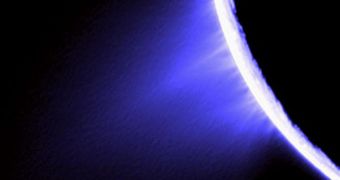Recent flybys of the icy Saturnine moon Enceladus have revealed the presence of salt in the icy particles spewed by geysers at its south pole. The discovery led scientists to calculate that the salinity of these jets is roughly the same as that in Earth's oceans, producing a hotspot for life.
The flight maneuvers were carried out by the NASA Cassini spacecraft, which has been orbiting Saturn, its moons and its ring system since July 1, 2004. In the meantime, the probe completed dozens of flybys of some of the gas giant's most interesting moons, Enceladus and Titan included.
Recently, the satellite was able to conduct a series of very low-altitude flybys of Enceladus' south pole, which is home to landscape features called tiger stripes. These contain cracks formed by geysers, from which organic particles and water vapors are vented.
These emissions may be contributing to the creation of a hotspot for life on the Saturnine moon, says Carolyn Porco, who is based at the University of Colorado in Boulder (UCB). She is the leader of the Cassini Imaging Science team, and also an expert on Enceladus itself.
“More than 90 jets of all sizes near Enceladus's south pole are spraying water vapor, icy particles, and organic compounds all over the place. Cassini has flown several times now through this spray and has tasted it,” Porco reveals.
“And we have found that aside from water and organic material, there is salt in the icy particles. The salinity is the same as that of Earth's oceans,” she goes on to say, adding that thermal measurement data indicate a temperature of about 190 degree Kelvin (-117ºFahrenheit or -83ºCelsius) near the geysers.
According to the expert, “if you add up all the heat, 16 gigawatts of thermal energy are coming out of those cracks.” When adding the facts that Enceladus may have a liquid ocean underground, and that it produces organic matter, you get an image of a world where extremophile bacteria could survive.
Microorganisms living in conditions (temperature included) such as those on the Saturnine moon have been discovered at numerous locations around the world. This means that, if life ever got a chance to develop on Enceladus, it may still exist there to this day.
“The kind of ecologies Enceladus might harbor could be like those deep within our own planet. Abundant heat and liquid water are found in Earth's subterranean volcanic rocks,” Porco explains.
“Organisms in those rocks thrive on hydrogen (produced by reactions between liquid water and hot rocks) and available carbon dioxide and make methane, which gets recycled back into hydrogen. And it's all done entirely in the absence of sunlight or anything produced by sunlight,” she concludes.

 14 DAY TRIAL //
14 DAY TRIAL //